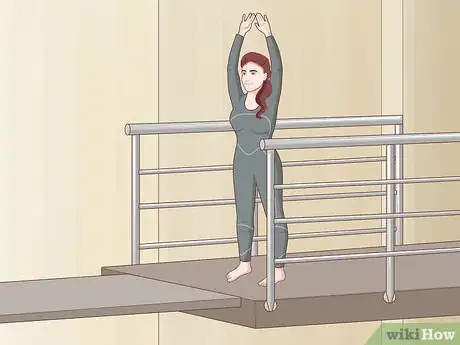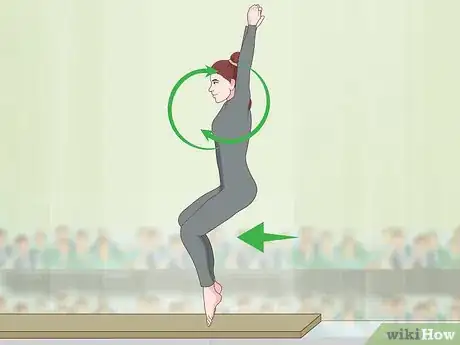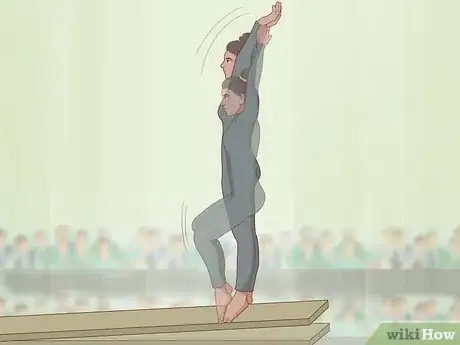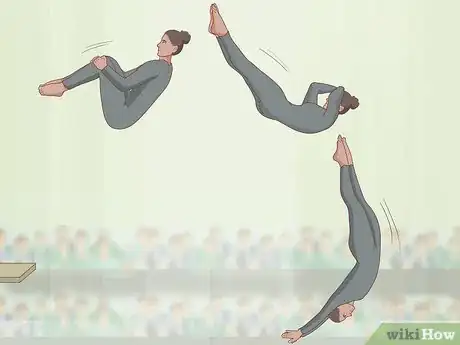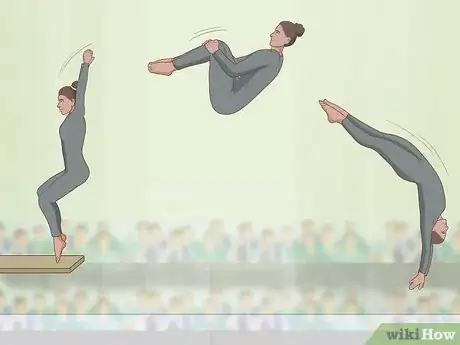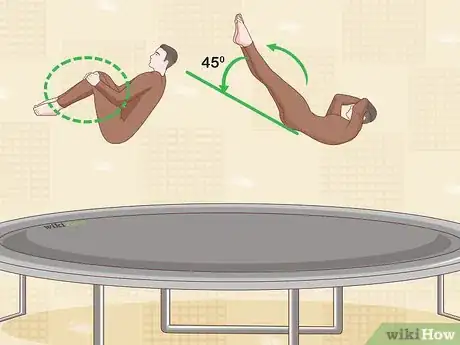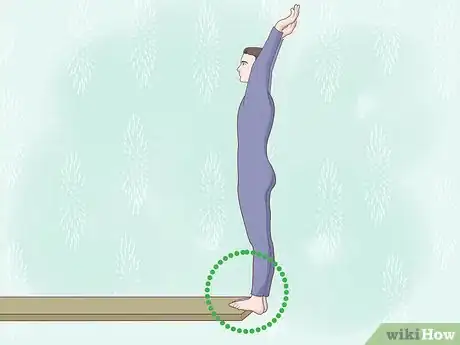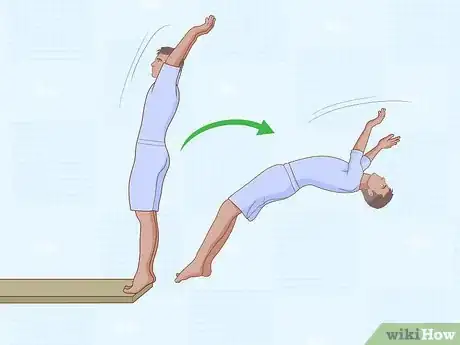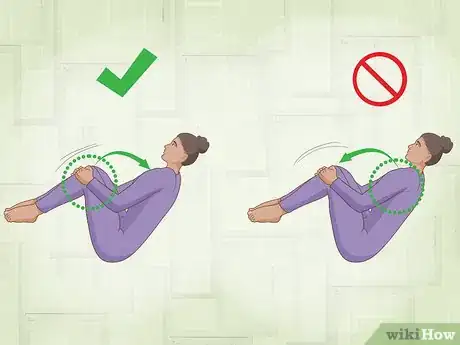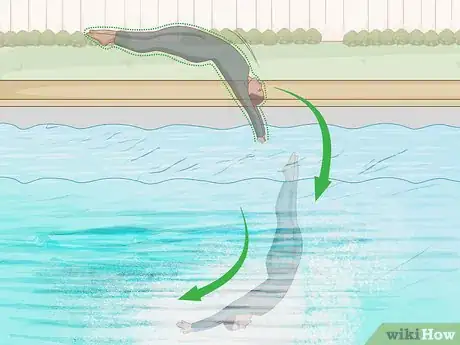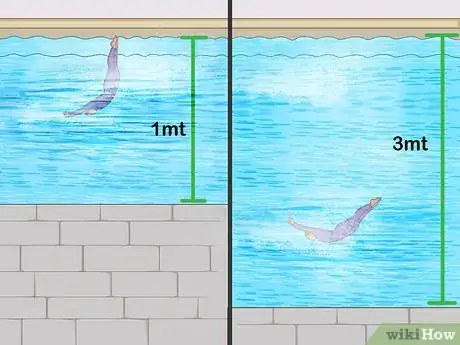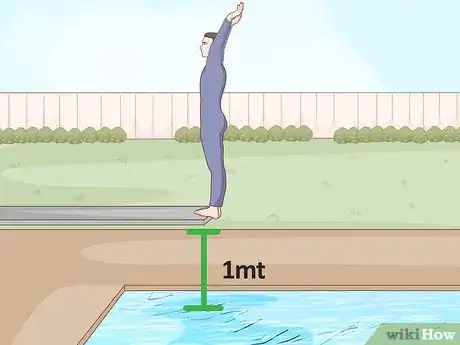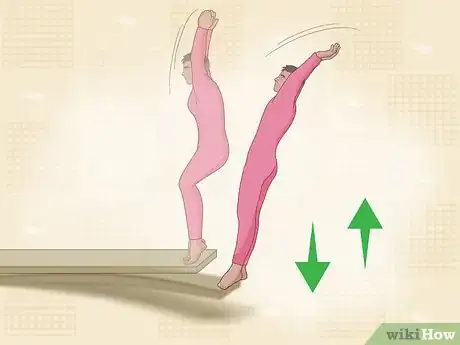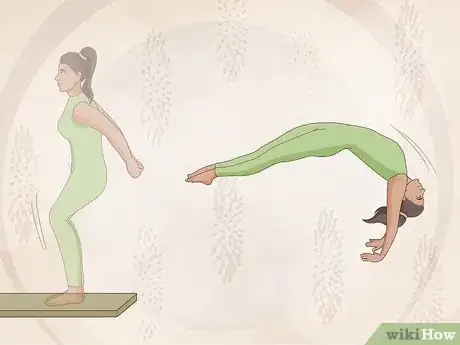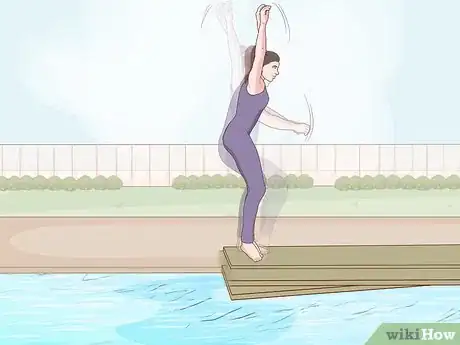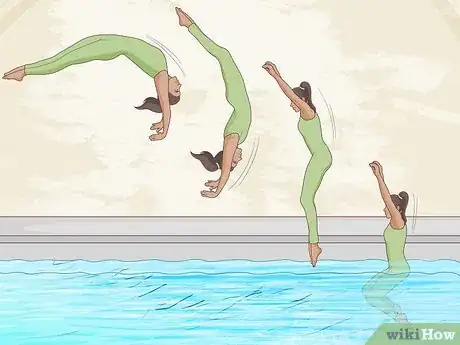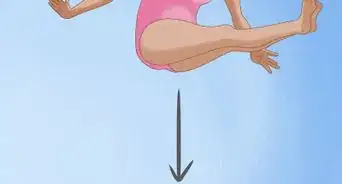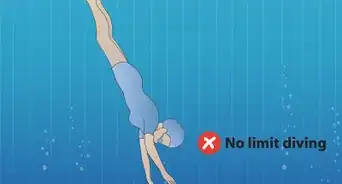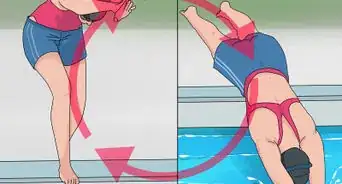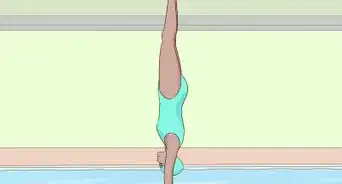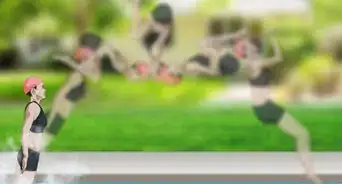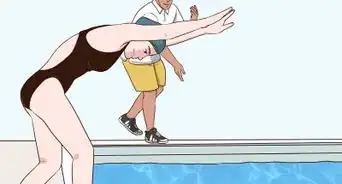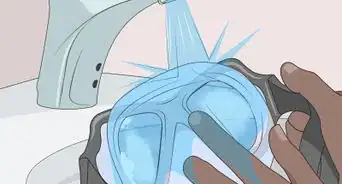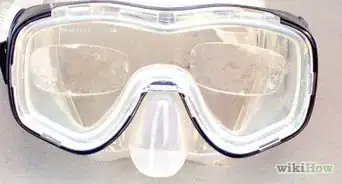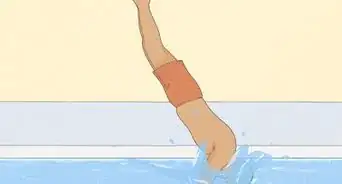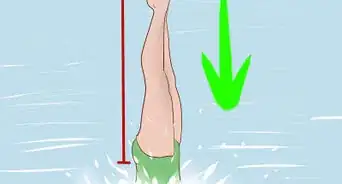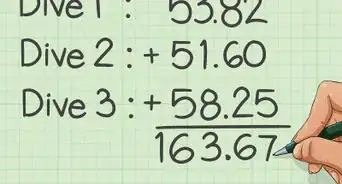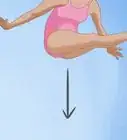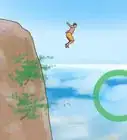This article was co-authored by Halle Payne, a trusted member of wikiHow's volunteer community. Halle Payne began diving at the age of 10. She coached the Brookwood Hills Bullfrogs' Dive Team from 2011-2013.
This article has been viewed 76,704 times.
Learn more...
Diving is a category all its own in the world of swimming. A key skill that many divers should know is the back dive. Learning how to back dive can be a difficult feat, and the best way to do it is with help from a coach or an experienced swimmer. With a lot of practice, control, and correct positioning of the legs and head, you’ll be back diving like a pro in no time.
Steps
Doing a Back Dive
-
1Warm up and find a good spot to practice. Get the blood flowing to your muscles to prevent injuries and loosen up. Do some stretching and/or some form of cardio as diving prep. Find a spot on the edge of the pool in the deep end to practice your dives. Do not dive into shallow water. If the water you’re diving in is nine feet deep or less, then the water is too shallow to dive in.
- Make sure you have a coach there with you to act as your spotter during your dives.[1]
- Start out diving as low as possible (from the side of the pool) and then work your way up to the diving board.
-
2Start off by doing a back jump dive. Stand at the edge of the pool with your back to the water. Raise your arms above your head so that your body is one straight line.
- Bend your legs. As soon as your knees bend, very quickly swing your arms backwards in a circular motion (or counter-clockwise). Your arms should make a full circle, coming back to stop beside your ears, hands together above your head in a dive position.
- Jump back (at least a foot away from the deck) into the water. Enter the water feet-first.
- Before, during, and after the dive, your arms should remain straight above your head. Your head and body should be aligned.
- Practice this a few times. Try to jump with your body held straight, but entering the water at an angle.
Advertisement -
3Position yourself to try a back dive. Go to the edge of the pool or the edge of the diving board and turn your back to the water. Allow your heels to hang over the side. Balance on the balls of your feet, onto your tip toes.[2]
- Mimic the movements you made with your arms when you practiced a back jump dive — they should be stretched above your head and your body should be in a straight line. If you are on the board, begin bouncing gently.
- Bend your legs in preparation to use the pressure to set up the action of diving in the next step. As you bend your knees, quickly rotate your arms behind you in a full circle, bringing them back to the original position beside your ears, hands above your head.
-
4Perform the back dive. Arch your back slowly. Continue arching until you feel your body begin to fall — at that point, push yourself backward off the board. As with the jump dive, try to keep your body in a straight line — your arms should be straight, your toes pointed.[3]
- You can attempt a back-bend first, which is the same thing without throwing yourself off the board or bouncing the board — you just let yourself fall into the water.
- Keep your eyes open as you dive so that you can see the water. This will assist you in keeping your head neutral, your and arms and your body straight as you enter the water.[4]
- Your hands should enter the water first, held in the diving position (or flat-hand position).
EXPERT TIPHalle Payne began diving at the age of 10. She coached the Brookwood Hills Bullfrogs' Dive Team from 2011-2013.Former Diving Coach
 Halle Payne
Halle Payne
Former Diving CoachIf you're nervous, a good way to start is to have a spotter. Halle Payne, former dive coach, adds: "Especially if you're small, a coach or friend can come up on the diving board with you to spot you. If not, someone can stand with you on the side of the pool with their hand in the small of your back to help guide you into the dive."
-
5Increase the speed of your dive. As you get more comfortable, you'll want to speed up the movements. Instead of slowly arching your back until you begin to fall, you should eventually reach a point where you are no longer falling back off the board or side of the pool — you are just launching yourself off into the water.[5]
Doing a Back Dive Tuck
-
1Perform drills to help you dive. After you warm up, use a trampoline to practice tucking. Your coach must be there to spot you so you don't hurt yourself. While standing on the trampoline, act as though you are doing a back jump. You will be jumping into the air and landing on your back on the trampoline.
- While you’re mid-jump on the trampoline, pull your knees against your chest, forming a tuck position. Grab your knees to your chest for second, then kick your legs out to 45 degree angle before landing.
- If locating a trampoline isn’t convenient for you, practice back jumps from the side of the pool deck you’re using. Do a back jump tuck directly into the water. Instead of landing flat on your back, try to enter the water smoothly at an angle.
- From there, move the jump up to the diving board from the deck. Get comfortable with the jumps and once you’ve completed a set of three to five jumps, try the dive.
-
2Position yourself for the back dive tuck. Once you feel comfortable with the tucking motion, you can practice diving into the water. Again, start low, diving off the edge of the pool into the deep end, and eventually work up to the diving board. As always, make sure your coach is there to spot you.
- Stand backwards on the edge of the pool or diving board with your heels hanging off the edge. Raise your arms above your head in the diving position — hands together, arms in line with your ears.
- If you are on the board, start bouncing gently. Let your arms drop behind you, whipping them around in a quick circular motion. As your arms return to their position above your head (imagine your entire body being in the 12 o'clock position on a clock), you’re ready to take your dive.
-
3Make the takeoff for your dive. Position your body at a slight backwards angle and jump up and away from the board.
- To help keep your head in a neutral position, try picking a point on the back of the diving board (or pool deck) and focusing on this spot as you dive.
-
4Start the tuck position. Without moving the upper part of your body (including your head — don't tilt back and look for the water), bring your knees to your chest (do not bring your chest toward your knees).
- Grab your shins as your knees come to your chest.
-
5Prepare to enter the water. Extend your legs for the kick-out and entry part of the dive. Make sure your body is tight during entry, especially your stomach muscles.
- Kick your legs out to a 45 degree angle.
- Keeping your legs at this angle, you can now look back toward the water.
- Bring your arms back up over your head to resume the flat-hand or diving position, moving them up along the center of your body.
- When you enter the water, your body should be almost vertical, positioned at a very slight angle.
-
6Gain control of the dive. Learn how to control your body during the back dive tuck to have the most successful dive. Practice the back dive tuck on 1-meter and 3-meter diving boards to master the movements.
Doing a Back Flip While You Dive
-
1Make sure you are prepared to dive. Have a coach there to act as your guide. You should be able to do a normal back dive off a 1-meter board without issue. You should also understand the basics of diving.
-
2Approach the dive by starting with a back press. Stand backwards on the edge of the 1-meter diving board. Your shoulders should be in a vertical line over your hips. Place your arms down at your sides.
- Keep your head in a neutral position and begin to rock the board.
- Lift your arms over your head, keeping them straight. Begin to quickly rotate your arms behind your body slightly.
- As you rotate your arms, bend your legs to prepare to jump from the board.
-
3Get ready to jump up and away from the board. Swing your arms forcefully into a back press. Keep your head aligned with your arms.
- Jump up and out off of the board.
- Once you’re in the air, your feet should be pointed towards the board and your body should be at a backward angle.
-
4Start the rotation of the back flip. Extend your arms in a straight position overhead near your ears. Point your legs towards the diving board at an angle in the air so that they “chase” your head and arms.
- Rotate your arms behind your body quickly in a small half-circle. This action will increase the momentum of the rotation for your flip.
- Bend your legs into a tuck position and grab onto your shins once your arms have completed the half-circle movement.
-
5Launch yourself to the come out position of the dive. Hold your tight tuck position briefly. Keep your eyes open. Look for the board and use it as your signal to come out of the somersault at the right time.
- Fold yourself out of the somersault/tuck position once you see the board. Aim your legs towards the water and slightly in front of you.
- Punch your feet into the water at a slight angle so that your body finishes the rotation you started.
- As you enter the water, place your arms at the sides of your body.
Community Q&A
-
QuestionDo I fall in straight?
 Community AnswerAlmost. With your hands above your head, look directly at them and bend in your back and open your shoulders a bit more. This should begin pulling you backwards. Jump and hold this position through water entry.
Community AnswerAlmost. With your hands above your head, look directly at them and bend in your back and open your shoulders a bit more. This should begin pulling you backwards. Jump and hold this position through water entry. -
QuestionThe picture was a little confusing. When doing a back dive, aren't you supposed to wait until the entry to arch?
 Community AnswerYes, you're right. Don't arch until you are about to touch the water with your fingertips.
Community AnswerYes, you're right. Don't arch until you are about to touch the water with your fingertips.
Warnings
- Never dive in water that is less than 8 feet (2.4 m) deep!⧼thumbs_response⧽
- Back flops will happen. These may cause redness and pain on the surface of your back. However, if your neck or shoulder hurts, stop. You might have pulled a muscle.⧼thumbs_response⧽
- Never dive off a board into water that is less than 12 feet (3.7 m) deep.⧼thumbs_response⧽
- Don't fall straight down, but don't throw yourself way out. Try to go about 1 1⁄2 feet (0.5 m) away from the board.⧼thumbs_response⧽
- Do not dive with goggles. The impact from the water can snap your goggles and it hurts badly.⧼thumbs_response⧽
Things You'll Need
- A trampoline
- A pool
